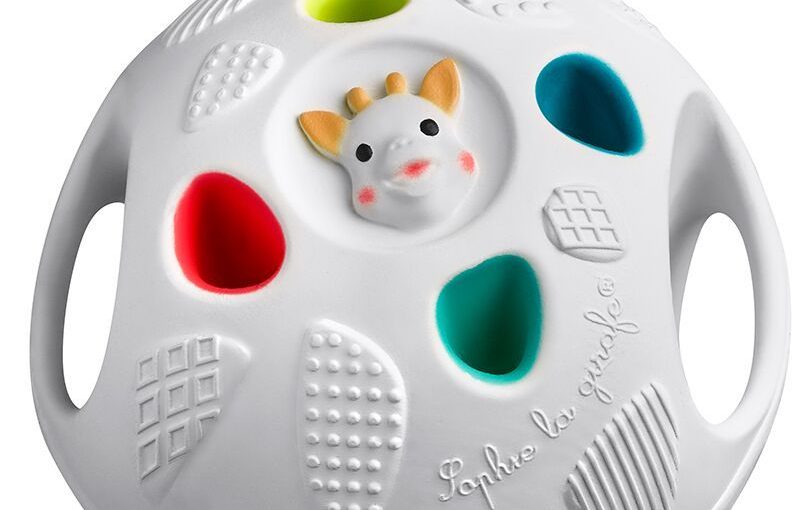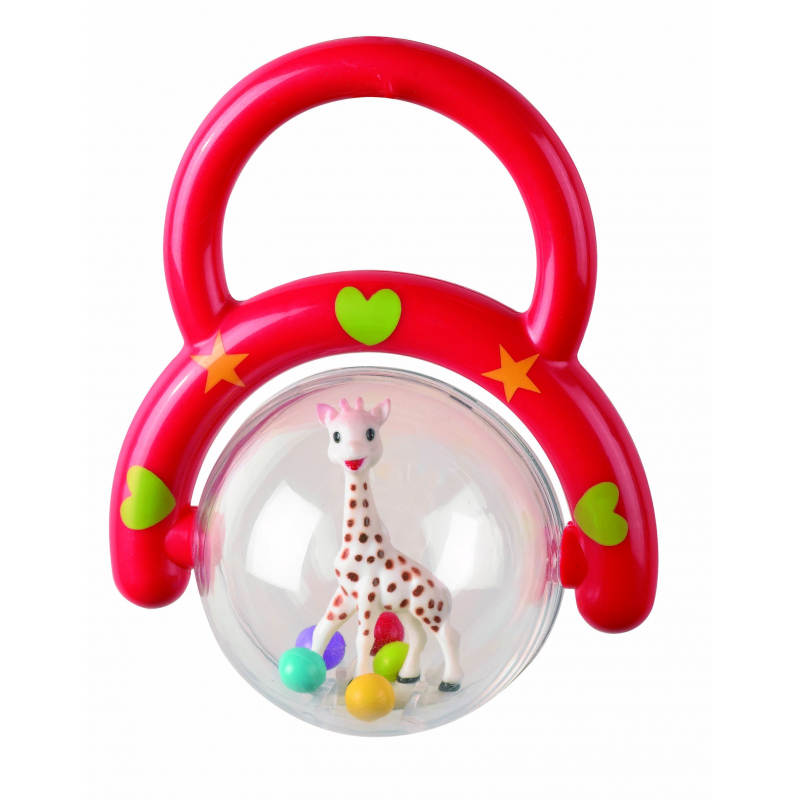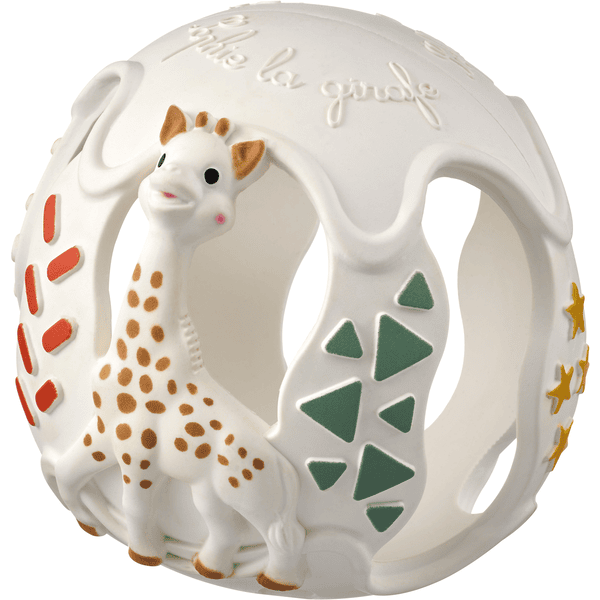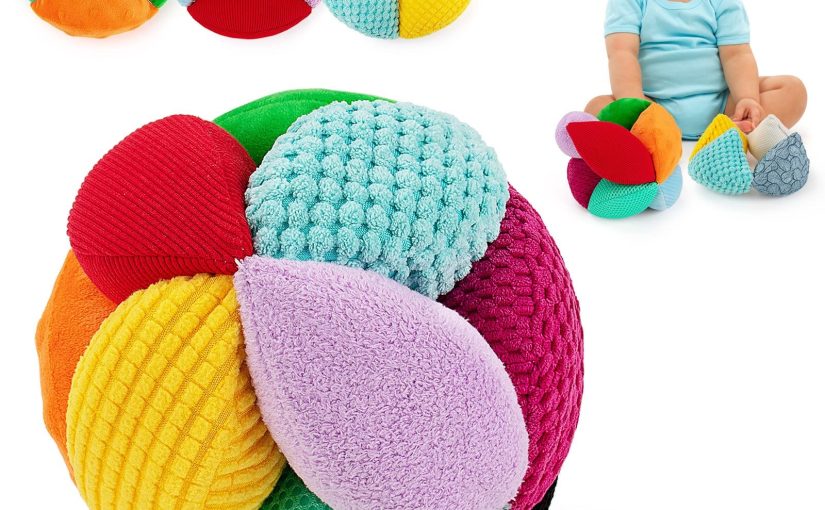What is Sophie Giraffe Sensory Ball?
The Sophie Giraffe Sensory Ball is a unique toy designed for infants. It’s part of the Sophie the Giraffe range, famous for its baby teething products. As with other toys in the series, it features the iconic giraffe figure that has charmed children for generations. This sensory ball is crafted to stimulate babies’ senses and assist in their early development. It’s made from safe, soft materials suitable for little hands to grasp and explore. The ball has textures, colors, and patterns to captivate babies’ attention. It also includes elements that make gentle sounds when the ball is squeezed or rolled, providing auditory stimulation. The toy is meant for babies from birth and up, serving as both a plaything and a developmental tool. In essence, the Sophie Giraffe Sensory Ball is a blend of fun and learning, offering a multisensory experience to support a baby’s growth.
Key Features and Benefits
The Sophie Giraffe Sensory Ball boasts several features that make it stand out as an excellent choice for your baby’s development. Each aspect is carefully designed to cater to the needs of growing infants and to be beneficial for their early sensory exploration.
Engaging Textures
The sensory ball includes various textures on its surface. These textures help babies discover and differentiate how different touches feel, nurturing their tactile senses.
Visual Appeal
Vibrant colors and patterns on the ball are visually stimulating for infants. They help to hold babies’ attention and can support visual development.
Auditory Stimulation
When the ball is squeezed or rolled, it emits gentle sounds. This feature encourages babies to learn the relationship between actions and reactions while aiding auditory development.
Safe, Non-toxic Materials
Made with baby-safe materials, the Sophie Giraffe Sensory Ball is non-toxic and soft. It’s easy for tiny hands to grip and safe for babies to chew on when they’re teething.
Lightweight and Durable
The design ensures that the ball is light enough for babies to handle with ease, yet durable to withstand the wear and tear of regular play.
Easy to Clean
Hygiene is vital, and the sensory ball is easy to clean. This factor ensures that the ball can be kept germ-free and safe for regular baby play.
By offering a variety of developmental benefits in one toy, the Sophie Giraffe Sensory Ball is a superb investment in your child’s early years. It not only provides entertainment but also plays a critical role in their learning and development.
How to Use Sophie Giraffe Sensory Ball for Baby’s Development
The Sophie Giraffe Sensory Ball is more than just a toy. It’s a developmental tool that can contribute significantly to your baby’s growth. Here’s how to leverage the sensory ball for your baby’s development:
Stimulate Tactile Skills
Encourage your baby to touch and feel the ball. The varied textures are perfect for tiny fingers to explore and will help enhance their sense of touch.
Enhance Visual Awareness
Roll the ball to catch your baby’s eye. The bright colors and patterns will fascinate them and help develop visual tracking skills.
Encourage Auditory Discovery
Squeeze the ball to make gentle sounds. This helps your baby connect actions to sounds, fine-tuning their hearing and cognitive skills.
Promote Motor Skills
Invite your baby to grasp, roll, or toss the Sophie Giraffe Sensory Ball. These actions are excellent for building muscle strength and motor coordination.
Reinforce Cause and Effect
Teach cause and effect by pressing the ball to create sounds. This will intrigue your baby and encourage them to experiment with the ball on their own.
Introduce Language Skills
Talk about the giraffe, the colors, and the sounds the ball makes. This can be a fun way to introduce new words and build language abilities.
Ensure Safe Playtime
Always supervise your baby during play to ensure a safe experience. Remember, the sensory ball is designed for your baby’s safe exploration.
Using the Sophie Giraffe Sensory Ball strategically in play can maximize its developmental benefits. It’s an effective way to stimulate your baby’s senses while keeping them engaged and happy.
Safety Considerations and Cleaning Tips
When it comes to baby products, safety is always the top priority. The Sophie Giraffe Sensory Ball is no exception. You should keep a few things in mind to ensure your baby has a safe playtime experience. First, always supervise your baby while they play with the ball. Even though it is designed with safety in mind, it’s important to be present in case your baby needs help. Secondly, regularly inspect the ball for any signs of wear and tear. If you notice any damage, it might be time to replace the toy to prevent any potential choking hazards.
Keeping the Sophie Giraffe Sensory Ball clean is crucial for maintaining hygiene, especially as babies are prone to put toys in their mouths. Cleaning the ball is simple; use mild soap and warm water to wipe it down. Avoid using harsh chemicals as they could be harmful to your baby and damage the ball’s material. After cleaning, make sure to dry the ball thoroughly before handing it back to your baby. It’s also a good practice to clean the ball after each play session, particularly if it has been used by multiple children or if it’s been on the floor.
In summary, always keep an eye on your baby during playtime, check the ball regularly for damage, and maintain cleanliness with gentle soap and water. By following these safety considerations and cleaning tips, you can ensure the Sophie Giraffe Sensory Ball continues to be a safe and enjoyable toy for your baby.
Comparing Sophie Giraffe Sensory Ball With Other Baby Toys
When selecting toys for your little one, you may wonder how the Sophie Giraffe Sensory Ball stacks up against other options. Here’s a comparison to guide your choice.
Variety of Sensory Features
Unlike many toys, the Sophie Giraffe Sensory Ball offers a unique combination of textures, colors, and sounds. This range of stimuli can be harder to find in other toys.
Safety and Non-toxicity
Safety is a prime concern for parents. The Sensory Ball is non-toxic and made from baby-safe materials, putting it ahead of toys that lack similar certifications.
Durability and Ease of Cleaning
Parents love durable and easy-care products. This ball is both long-lasting and simple to clean, making it more convenient than plush toys that require machine washing.
Developmental Focus
While many toys offer fun, few are created with a baby’s development in mind. The Sensory Ball is designed to promote sensory and motor skills actively.
Portability
Some baby toys are large and bulky, but the Sensory Ball’s lightweight design is perfect for on-the-go families.
Price Point
Considering its developmental benefits, the Sensory Ball is competitively priced compared to other toys that provide fewer learning opportunities.
When compared with other baby toys, the Sophie Giraffe Sensory Ball presents a balanced package of safety, developmental support, and practicality that parents appreciate.
Where to Buy Sophie Giraffe Sensory Ball
Finding the right place to buy the Sophie Giraffe Sensory Ball is easy. It’s available at many popular retail outlets. You can purchase it online or at brick-and-mortar stores. When seeking online options, consider trusted retailers like Amazon, Walmart, and Target. They often provide competitive pricing and the convenience of home delivery.
For those who prefer to shop in person, check out local baby stores or department stores. They might have the sensory ball in stock for you to see and touch before buying. This experience can be reassuring as you assess the toy’s quality firsthand.
Beyond these, specialty children’s boutiques and toy shops may carry the Sophie Giraffe Sensory Ball. Shops focusing on eco-friendly and non-toxic baby products are likely to stock it due to its safe materials.
When choosing where to buy, look out for places that offer good return policies. This can be helpful if the product does not meet your expectations. Prices can vary, so shopping around to compare deals is wise. Look for sales events or special promotions to save money.
Wherever you decide to buy the Sophie Giraffe Sensory Ball, ensure it’s from a reputable source. This helps to guarantee that you’re getting an authentic product that’s safe and high quality for your baby.
Real Parents’ Experiences With Sophie Giraffe Sensory Ball
For many parents, choosing toys that contribute to their baby’s development is crucial. Reviews and testimonials from other parents can provide valuable insight. Here’s what some parents have said about Sophie Giraffe Sensory Balls, based on their firsthand experience.
Positive Feedback
Parents often report that their babies are drawn to the sensory ball’s bright colors and textures. The variety of patterns and the sounds it makes seem to captivate infants’ attention quite effectively. Many praise its durability, often mentioning that it withstands biting and drooling well, a common occurrence during teething phases.
Developmental Milestones
Some parents have noticed that, with regular play, their babies exhibit improvements in grasping and reaching skills. This enhances their motor skills and coordination. The cause-and-effect realization, when the ball makes a sound after being squeezed, is another developmental milestone parents have observed.
Safety and Hygiene Appreciation
The fact that the ball is made from non-toxic materials and is easy to clean is frequently appreciated. Parents seem to be reassured by the safety aspect, finding comfort in knowing that the ball is safe for their baby to chew on.
Comparisons With Other Toys
In comparison to other toys, the Sophie Giraffe Sensory Ball often comes out on top for many families. Parents appreciate the balance it offers between fun and development, stating it is more engaging than some standard toys.
While most feedback is positive, it’s important to note that all babies are different, and what works for one may not work for another. Still, the general sentiment from parents indicates that the Sophie Giraffe Sensory Ball is a beneficial addition to their baby’s playtime regime, combining fun, development, and peace of mind in one simple toy.
Frequently Asked Questions About Sophie Giraffe Sensory Ball
As a trusted tool for infant development, the Sophie Giraffe Sensory Ball raises various questions from curious parents. To help you, we’ve compiled a list of frequently asked questions along with concise answers.
Is the Sophie Giraffe Sensory Ball safe for newborns?
Yes, it’s designed for safety from birth onwards with baby-safe, non-toxic materials.
Can the sensory ball help with teething?
Absolutely. The soft material is safe for chewing, providing comfort to teething babies.
How does it promote sensory development?
Through its diverse textures, colors, and sounds, it stimulates tactile, visual, and auditory senses.
Is the ball easy to clean?
Yes, simply wash with mild soap and warm water, and ensure it’s fully dried before use.
Will it withstand frequent use?
It’s made to be durable, standing up well to regular play and exploration by infants.
Can the ball be used to teach cause and effect?
Indeed. Squeezing the ball creates sounds, helping babies learn about cause and effect.
Is this toy portable for travel?
With its lightweight design, it’s perfect for families on the move.
Where is the best place to buy the sensory ball?
Consider reputable online or local stores; shop around for the best price and return policies.
Understanding the benefits and uses of the Sophie Giraffe Sensory Ball can aid parents in making an informed decision for their child’s developmental needs. The sensory ball is not just a toy, but a valuable investment in your baby’s early growth and exploration of the world.







